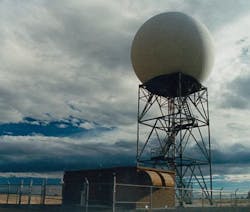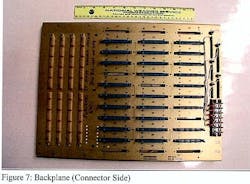National Weather service eyes backplane and circuit card upgrades to NEXRAD weather radar
SILVER SPRING, Md., 22 April 2013. Weather radar experts at the U.S. National Weather Service in Silver Spring, Md., are looking for companies able to upgrade embedded computing the WSR-88D NEXRAD radar by replacing a backplane and four transmitter control and monitoring circuit cards.
The National Oceanic and Atmospheric Administration (NOAA) issued a source-sought notice last Thursday (NOAA-ROC-CCA-BACKPLANE-04-18-13) for the NEXRAD Weather Surveillance Radar Transmitter Control and Monitoring System - Unit Functionality Discussion program.
The project seeks to develop and acquire a new transmitter control and monitoring system for the WSR-88D Next-Generation Radar (NEXRAD) system. NEXRAD is a network of 159 high-resolution S-band Doppler weather radars located throughout the continental U.S. that detects precipitation and atmospheric movement or wind. One of its chief functions is to provide real-time data for tornado prediction.
NEXRAD radars were installed between 1992 and 1997 at locations chosen to provide the most overlapping coverage between radars in case one failed during severe weather. Unisys Corp. of Blue Bell, Pa., designed and installed the NEXRAD systems.
The sources-sought notice will help the Weather Service conduct market research to replace four existing transmitter control and monitoring circuit card assemblies (CCAs) and one backplane unit that uses wire wrap technology.
| Related stories -- Radar technology looks to the future -- Pocket-sized USB interfaces to ARINC 708 weather radar avionics introduced by Ballard -- The ultimate in weather forecasting. |
Weather Service officials want to replace the four transmitter control and monitoring circuit cards with up-to-date technology and replace the hard-wired back plane with a printed wiring board type circuit card assembly.
Weather Service experts say they plan to acquire as many as 220 sets of the circuit card assemblies and backplanes for replacements and spare parts for the WSR-88D NEXRAD radar transmitter field sites.
Each card installs into a slot on the backplane using 3 x 100 pin connectors held in place in a card cage enclosure. Each card also supports test points for diagnostics. These test points involve DC voltages that are subject to power surges, and each redesigned circuit card must fit within the same space as the existing cards.
Each card is about 11.5 inches high, and 19 inches deep. An adapter cable may need to be developed to interface with the back lane. Fuse schemes also may need to be developed to mitigate power surges.
A high-level description of the functionality of each card and their internal reference designation used by the WSR-88D program is available in a .pdf document entitled CCA&Backplane RFI Functionality Discussion 28Feb12, which is online at http://www.fbo.gov/utils/view?id=fce5129770ac0b0121719f3c562b641d.
The control and monitoring circuit cards consist of the control adaptor, control logic, control interface, and remote monitoring subsystem (RMS) interface. Operation of the transmitter is controlled by the control and monitoring circuit cards. These circuits provide front panel metering for voltages and currents, fault monitoring status indications, transmitter status, and external interfacing with the main data processor.
The backplane is based on wire-wrap technology mounted to an aluminum support structure measuring about 18 by 14 inches. The 27 50-pin connectors used are obsolete and need to be upgraded. Additional connections consist of four 3 x 100 circuit card connections, five single-row groups DC distribution connections, and one six terminal block.
Companies interested should respond no later than 3 May 2013 by email to the National Weather Service's Daniel Hoffman at [email protected].
Responses to this RFI must demonstrate sufficient experience and capability to modernize the current NEXRAD design, including the history, level of complexity, and customer points of contact for past similar contracts. Responses also must describe facility and personnel resources concerning circuit card design and prototyping.
For questions or concerns email Glenn Secrest at [email protected], with a copy to Daniel Hoffman at [email protected].
More information is online at https://www.fbo.gov/spg/DOC/NOAA/OCSNWS/NOAA-ROC-CCA-BACKPLANE-04-18-13/listing.html


